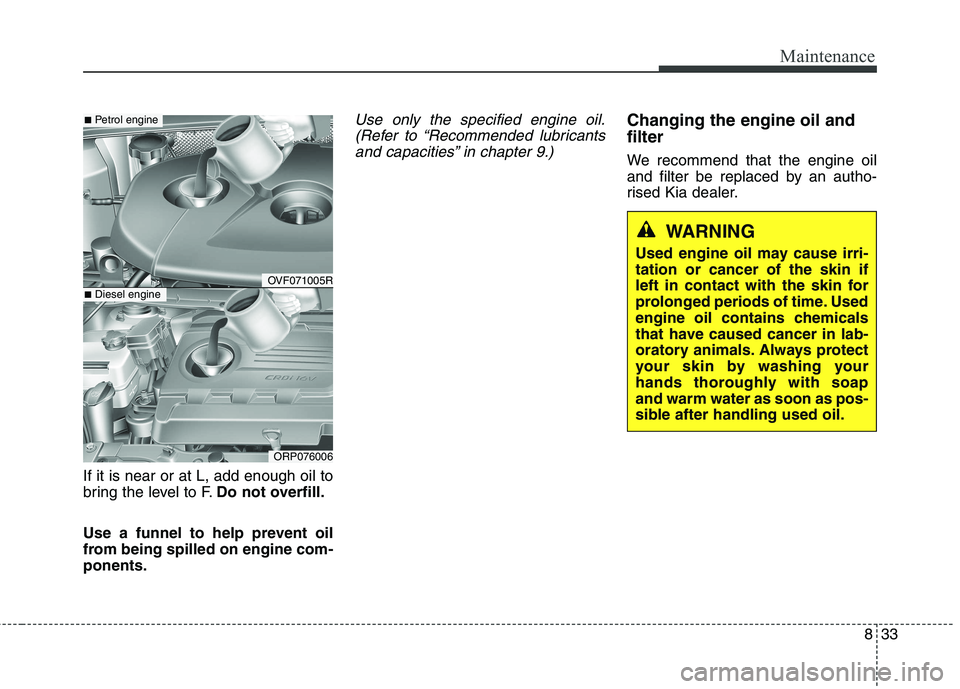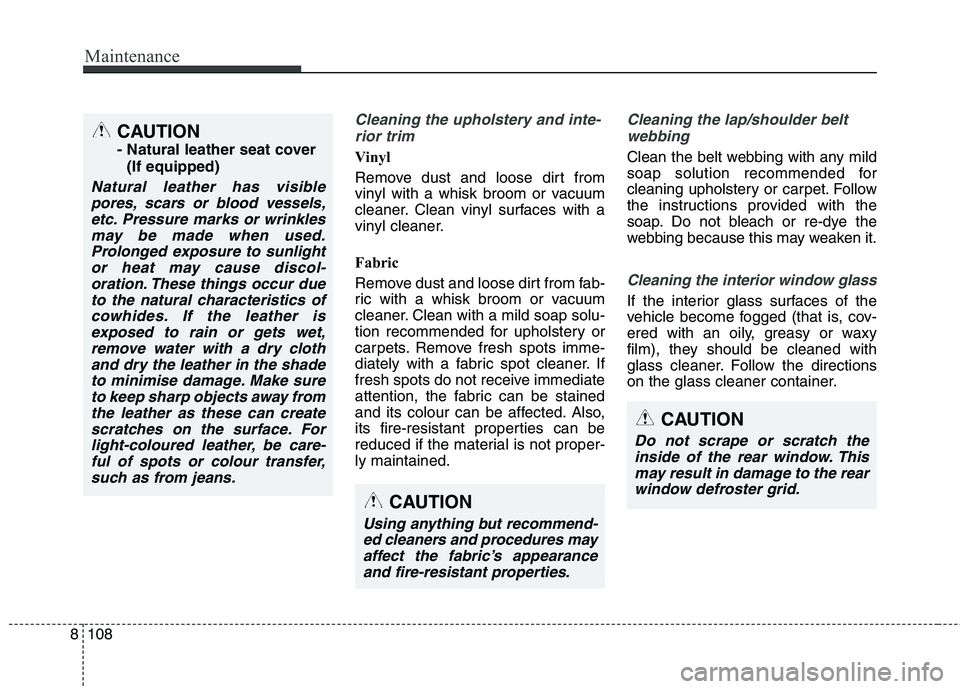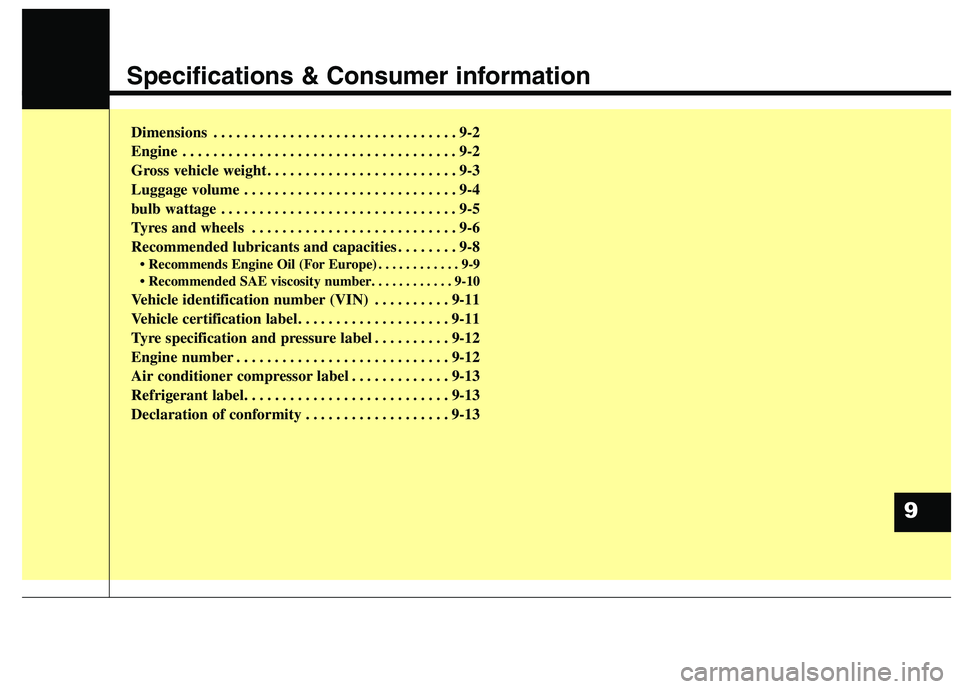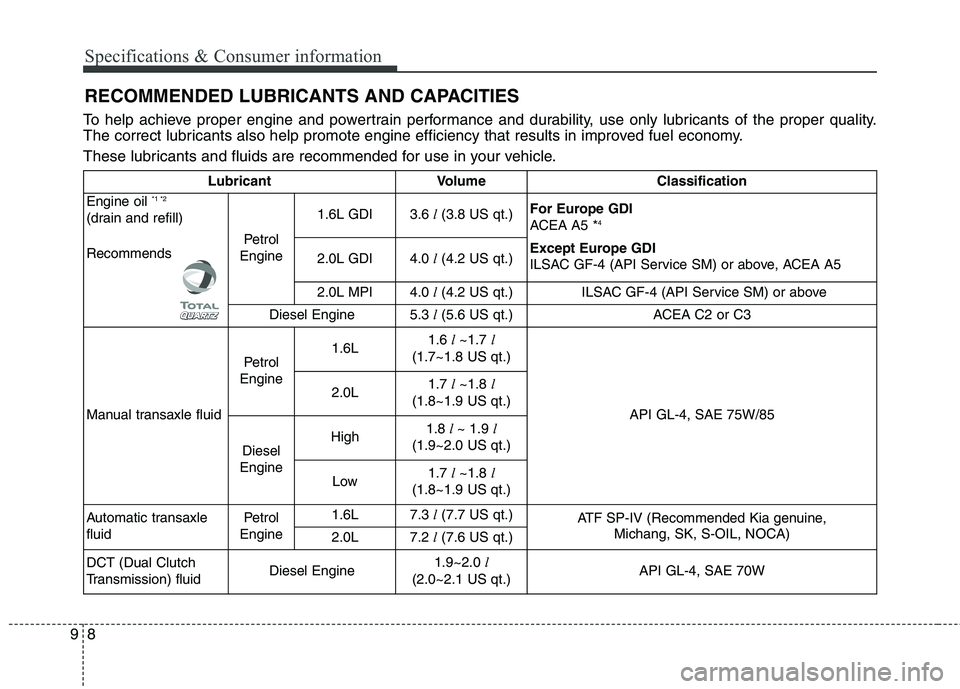2017 KIA CARENS RHD recommended oil
[x] Cancel search: recommended oilPage 9 of 723

Introduction
6
1
Operation in foreign countries
If you are going to drive your vehicle
in another country, be sure to:
Observe all regulations regarding
registration and insurance.
Determine that acceptable fuel is available. Diesel engineDiesel fuel
Diesel engine must be operated only
on commercially available diesel fuelthat complies with EN 590 or compa-
rable standard. (EN stands for
"European Norm"). Do not use
marine diesel fuel, heating oils, or
non-approved fuel additives, as this
will increase wear and cause dam-age to the engine and fuel system.
The use of non-approved fuels and /
or fuel additives will result in a limita-
tion of your warranty rights.
Diesel fuel of above cetane 51 is
used in your vehicle. If two types of
diesel fuel are available, use summer
or winter fuel properly according to
the following temperature conditions.
Above -5°C (23°F) ... Summer type
diesel fuel.
Below -5°C (23°F) ... Winter type diesel fuel.
Watch the fuel level in the tank very
carefully : If the engine stops through
fuel failure, the circuits must be com-
pletely purged to permit restarting.
CAUTION
Do not let any petrol or water enter the tank. This would makeit necessary to drain it out and to bleed the lines to avoid jam-ming the injection pump anddamaging the engine.
CAUTION - Diesel Fuel
(if equipped with DPF)
It is recommended to use the regulated automotive diesel fuelfor diesel vehicle equipped with the DPF system.
If you use diesel fuel includinghigh sulfur (more than 50 ppmsulfur) and unspecified addi-tives, it can cause the DPF sys- tem to be damaged and whitesmoke can be emitted.
Page 533 of 723

Driving your vehicle
98
6
Use high quality ethylene gly- col coolant
Your vehicle is delivered with high
quality ethylene glycol coolant in the
cooling system. It is the only type ofcoolant that should be used because
it helps prevent corrosion in the cool-
ing system, lubricates the water
pump and prevents freezing. Be sure
to replace or replenish your coolantin accordance with the maintenance
schedule. Before winter, have yourcoolant tested to assure that its
freezing point is sufficient for the
temperatures anticipated during the
winter.
Check battery and cables
Winter puts additional burdens on
the battery system. Visually inspect
the battery and cables as described
in chapter 8. We recommend that the
system be checked by an authorised
Kia dealer. Change to "winter weight" oil
if necessary In some climates it is recommended
that a lower viscosity "winter weight"
oil be used during cold weather. See
chapter 9 for recommendations. If
you aren't sure what weight oil you
should use, we recommend that you
consult an authorised Kia dealer.
Check spark plugs and igni- tion system
Inspect your spark plugs as
described in chapter 8 and replace
them if necessary. Also check all
ignition wiring and components to be
sure they are not cracked, worn or
damaged in any way.
CAUTION
Chains that are the wrong size
or improperly installed candamage your vehicle's brakelines, suspension, body andwheels.
Stop driving and retighten the chains any time you hear themhitting the vehicle.
WARNING - Tyre chains
The use of chains may adversely affect vehicle han- dling.
Do not exceed 30 km/h (20 mph) or the chain manufactur-
er’s recommended speed
limit, whichever is lower.
Drive carefully and avoid bumps, holes, sharp turns,
and other road hazards, which
may cause the vehicle to
bounce.
Avoid sharp turns or locked- wheel braking.
Page 604 of 723

817
Maintenance
MAINTENANCE UNDER SEVERE USAGE CONDITIONS - FOR EUROPE, EXCEPT RUSSIA
The following items must be serviced more frequently on cars mainly used under severe driving conditions.
Refer to the chart below for the appropriate maintenance intervals.
R : Replace I : Inspect and if necessary, adjust, correct, clean or replace
Maintenance itemMaintenanceoperationMaintenance intervalsDriving Condition
Engine oil and engine oil filterREvery 15,000 km (10,000 miles) or 12 monthsA, B, C, D, E, F, G, H, I, J, K
REvery 15,000 km (10,000 miles) or 12 monthsA, B, C, F, G, H, I, J, K
Air cleaner filterRReplace more frequently depending on the conditionC, E
Manual transaxle fluid (if equipped)REvery 120,000 km (80,000 miles)C, D, E, F, G, H, I, K
Automatic transaxle fluid (if equipped)REvery 90,000 km (60,000 miles)A, C, D, E, F, G, H, I, K
Dual clutch transmission fluid (if equipped)REvery 120,000 km (80,000 miles)C, D, E, F, G, H, I, K
Steering gear rack, linkage and bootsIInspect more frequently depending on the conditionC, D, E, F, G
Petrol *1
Diesel * 2
* 1
: If the recommended oil and oil filter are not available, replace engine oil and engine oil filter every 7,500 km or 6 months for GDI engine.
* 2
: If the recommended oil is not available, replace engine oil and engine oil filter every 10,000 km or 6 months.
Page 620 of 723

833
Maintenance
If it is near or at L, add enough oil to
bring the level to F.Do not overfill.
Use a funnel to help prevent oil
from being spilled on engine com-ponents.
Use only the specified engine oil. (Refer to “Recommended lubricantsand capacities” in chapter 9.)Changing the engine oil and filter
We recommend that the engine oil
and filter be replaced by an autho-
rised Kia dealer.
OVF071005R
■ Petrol engine
ORP076006
■Diesel engine
WARNING
Used engine oil may cause irri- tation or cancer of the skin if
left in contact with the skin for
prolonged periods of time. Used
engine oil contains chemicals
that have caused cancer in lab-
oratory animals. Always protect
your skin by washing your
hands thoroughly with soapand warm water as soon as pos-
sible after handling used oil.
Page 625 of 723

Maintenance
38
8
BRAKE/CLUTCH FLUID (IF EQUIPPED)
Checking the brake/clutch
fluid level
Check the fluid level in the reservoir
periodically. The fluid level should be
between MAX and MIN marks on the
side of the reservoir.
Before removing the reservoir cap
and adding brake/clutch fluid, clean
the area around the reservoir cap
thoroughly to prevent brake/clutchfluid contamination.
If the level is low, add fluid to the
MAX level. The level will fall with
accumulated mileage. This is a nor-mal condition associated with the
wear of the brake linings. If the fluid level is excessively low, werecommend that the system be
checked by an authorised Kia dealer.
Use only the specified brake fluid.
(Refer to “Recommended lubricantsand capacities” in chapter 9.)
Never mix different types of fluid.
ORP076084R
WARNING - Brake /
clutch fluid
When changing and adding
brake/clutch fluid, handle it
carefully. Do not let it come in
contact with your eyes. If
brake/clutch fluid should come
in contact with your eyes, imme-
diately flush them with a large
quantity of fresh tap water. Have
your eyes examined by a doctor
as soon as possible.
WARNING - Loss of
brake/clutch fluid
In the event the brake/clutch
system requires frequent addi-
tions of fluid, we recommend
that the system be inspected by
an authorised Kia dealer.
CAUTION
Do not allow brake/clutch fluid to contact the vehicle's bodypaint, as paint damage will result. Brake/clutch fluid, whichhas been exposed to open airfor an extended time should never be used as its quality can-not be guaranteed. It should beproperly disposed. Don't put in the wrong kind of fluid. A fewdrops of mineral-based oil, suchas engine oil, in your brake/ clutch system can damagebrake/clutch system parts.
Page 695 of 723

Maintenance
108
8
Cleaning the upholstery and inte-
rior trim
Vinyl
Remove dust and loose dirt from
vinyl with a whisk broom or vacuum
cleaner. Clean vinyl surfaces with a
vinyl cleaner.
Fabric
Remove dust and loose dirt from fab-
ric with a whisk broom or vacuum
cleaner. Clean with a mild soap solu-
tion recommended for upholstery or
carpets. Remove fresh spots imme-
diately with a fabric spot cleaner. If
fresh spots do not receive immediate
attention, the fabric can be stained
and its colour can be affected. Also,
its fire-resistant properties can be
reduced if the material is not proper-ly maintained.
Cleaning the lap/shoulder beltwebbing
Clean the belt webbing with any mild
soap solution recommended for
cleaning upholstery or carpet. Follow
the instructions provided with the
soap. Do not bleach or re-dye the
webbing because this may weaken it.
Cleaning the interior window glass
If the interior glass surfaces of the
vehicle become fogged (that is, cov-
ered with an oily, greasy or waxy
film), they should be cleaned with
glass cleaner. Follow the directions
on the glass cleaner container.
CAUTION
Do not scrape or scratch theinside of the rear window. Thismay result in damage to the rear window defroster grid.
CAUTION
Using anything but recommend-ed cleaners and procedures mayaffect the fabric’s appearance and fire-resistant properties.
CAUTION
- Natural leather seat cover
(If equipped)
Natural leather has visiblepores, scars or blood vessels,etc. Pressure marks or wrinkles may be made when used.Prolonged exposure to sunlightor heat may cause discol- oration. These things occur dueto the natural characteristics ofcowhides. If the leather is exposed to rain or gets wet,remove water with a dry clothand dry the leather in the shadeto minimise damage. Make sure to keep sharp objects away fromthe leather as these can createscratches on the surface. For light-coloured leather, be care-ful of spots or colour transfer,such as from jeans.
Page 700 of 723

Specifications & Consumer information
Dimensions . . . . . . . . . . . . . . . . . . . . . . . . . . . . . . . . 9-2
Engine . . . . . . . . . . . . . . . . . . . . . . . . . . . . . . . . . . . . 9-2
Gross vehicle weight. . . . . . . . . . . . . . . . . . . . . . . . . 9-3
Luggage volume . . . . . . . . . . . . . . . . . . . . . . . . . . . . 9-4
bulb wattage . . . . . . . . . . . . . . . . . . . . . . . . . . . . . . . 9-5
Tyres and wheels . . . . . . . . . . . . . . . . . . . . . . . . . . . 9-6
Recommended lubricants and capacities . . . . . . . . 9-8• Recommends Engine Oil (For Europe) . . . . . . . . . . . . 9-9
Vehicle identification number (VIN) . . . . . . . . . . 9-11
Vehicle certification label. . . . . . . . . . . . . . . . . . . . 9-11
Tyre specification and pressure label . . . . . . . . . . 9-12
Engine number . . . . . . . . . . . . . . . . . . . . . . . . . . . . 9-12
Air conditioner compressor label . . . . . . . . . . . . . 9-13
Refrigerant label. . . . . . . . . . . . . . . . . . . . . . . . . . . 9-13
Declaration of conformity . . . . . . . . . . . . . . . . . . . 9-13
9
Page 707 of 723

Specifications & Consumer information
8
9
RECOMMENDED LUBRICANTS AND CAPACITIES
To help achieve proper engine and powertrain performance and durability, use only lubricants of the proper quality.
The correct lubricants also help promote engine efficiency that results in improved fuel economy.
These lubricants and fluids are recommended for use in your vehicle.
Lubricant Volume Classification
Engine oil *1 *2
(drain and refill) Recommends Petrol
Engine 1.6L GDI
3.6
l(3.8 US qt.) For Europe GDI
ACEA A5 *
4
Except Europe GDI
ILSAC GF-4 (API Service SM) or above, ACEA A5
2.0L GDI
4.0
l(4.2 US qt.)
2.0L MPI4.0 l(4.2 US qt.)ILSAC GF-4 (API Service SM) or above
Diesel Engine 5.3
l(5.6 US qt.)
ACEA C2 or C3
Manual transaxle fluid Petrol
Engine 1.6L
1.6
l~1.7 l
(1.7~1.8 US qt.)
API GL-4, SAE 75W/85
2.0L1.7 l~1.8 l
(1.8~1.9 US qt.)
Diesel
Engine High
1.8
l ~ 1.9 l
(1.9~2.0 US qt.)
Low 1.7
l~1.8 l
(1.8~1.9 US qt.)
Automatic transaxle fluid Petrol
Engine 1.6L
7.3
l(7.7 US qt.)
ATF SP-IV (Recommended Kia genuine,
Michang, SK, S-OIL, NOCA)
2.0L 7.2
l(7.6 US qt.)
DCT (Dual Clutch
Transmission) fluid Diesel Engine1.9~2.0
l
(2.0~2.1 US qt.) API GL-4, SAE 70W